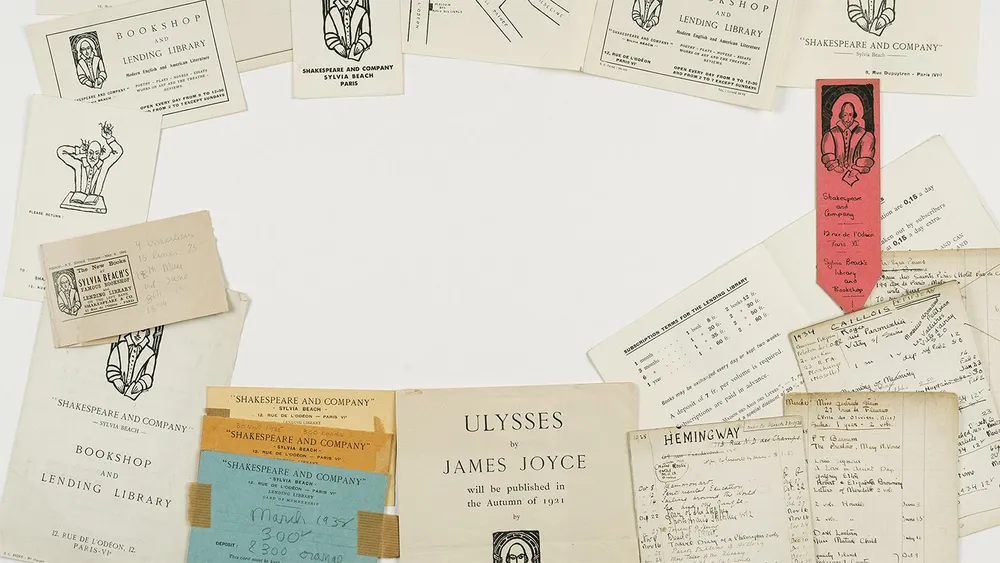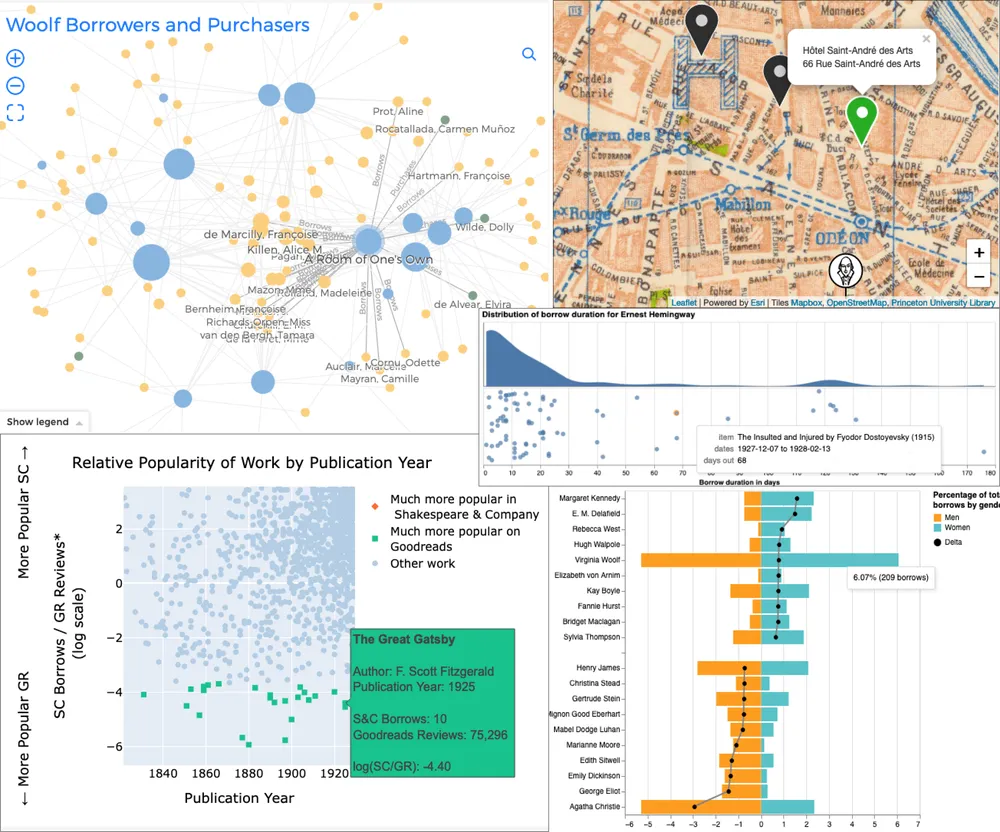Article Cluster Illuminates “The World of Shakespeare and Company”
29 May 2024
Articles use data from the Shakespeare and Company Project to glean new insights on the celebrated bookshop and lending library, reading communities, and the modernist movement.

“What’s left to learn about Shakespeare and Company?”
The question motivates “The World of Shakespeare and Company,” a new cluster of articles co-published by the Journal of Cultural Analytics (JCA) and Modernism/modernity (M/m) and edited by Joshua Kotin, associate professor of English at Princeton University, and Rebecca Sutton Koeser, lead research software engineer at The Center for Digital Humanities at Princeton (CDH).
The cluster features eight articles using data from the Shakespeare and Company Project, a CDH-sponsored digital humanities initiative and web application launched four years ago, in May 2020. Kotin and Koeser serve as project director and technical lead of the Project, respectively, which centers on Sylvia Beach’s celebrated bookshop and lending library in interwar Paris. Among Shakespeare and Company’s members were Gertrude Stein, James Joyce, Ernest Hemingway, and hundreds of other intellectuals, artists, and everyday readers who have been identified by Project researchers.
The Project allows users to explore Shakespeare and Company’s members and holdings—that is, the books that circulated at the lending library. It also offers public access to three datasets—members, books, and events (which comprises borrows and purchases, among other activities)—derived from Shakespeare and Company’s lending library cards, logbooks, address books, and inventories, many of which are available in the Beach Papers, held at Special Collections at Princeton University Library.

Ernest Hemingway’s 1925 lending library card and borrowing records drawn from it.
The Shakespeare and Company Project allows researchers not only to view members’ lending library cards, such as Ernest Hemingway’s 1925 card above, but also to see and interact with their borrowing and purchasing records.
As Kotin and Koeser write in their introduction (JCA, M/m), the essays in the cluster use these datasets to explore and analyze a wide range of topics—from individual authors (Virginia Woolf) and lending library members (Reed Peggram); to questions of canonization; to communities of readers, such as the Black intellectuals who frequented Shakespeare and Company; to methodological issues in the digital humanities.
“Readers of the cluster will learn about the differences between Woolf’s conception of ‘the common reader’ (a central idea in her work) and her actual readers in Paris; about how the reading habits of a small community of expatriates and French intellectuals determined the modernist canon; and how researchers might respond to the gaps that almost inevitably perforate historical archives,” Kotin explains. “The articles in the cluster transform Shakespeare and Company into a key for understanding literary history in the early twentieth century.”
By featuring articles that both engage with data produced by Project researchers and apply computational approaches to arrive at new insights, the cluster, write Kotin and Koeser, shows that the “Shakespeare and Company Project is a work of scholarship and an instrument of scholarship.”
Table of Contents
Introduction
- “The World of Shakespeare and Company: An Introduction” (JCA, M/m)
Joshua Kotin and Rebecca Sutton Koeser
Authors, Readers, and Books
- “Virginia Woolf’s Common Readers in Paris” (JCA, M/m)
Helen Southworth, Alice Staveley, Matthew Hannah, Claire Battershill, and Elizabeth Wilson - “Unpacking Reed Peggram’s Library” (JCA, M/m)
Ethelene Whitmire - “Sylvia Beach’s Final Book” (JCA, M/m)
Keri Walsh
Reading Practices
- “A Counterfactual Canon” (JCA, M/m)
Fedor Karmanov and Joshua Kotin - “The Afterlives of Shakespeare and Company in Online Social Readership” (JCA, M/m)
Maria Antoniak, David Mimno, Rosamond Thalken, Melanie Walsh, Matthew Wilkens, and Gregory Yauney
Communities
- “Black Internationalism and Shakespeare and Company” (JCA, M/m)
Caitlin O’Keefe - “Lending Books on the Left and Right Banks: Borrowing Practices at the American Library in Paris and Shakespeare and Company” (JCA, M/m)
Nissa Ren Cannon
Archival Absences
The cluster’s co-publication in the Journal of Cultural Analytics, where Kotin and Koeser previously published an article about the Shakespeare and Company Project datasets, and Modernism/modernity not only broadens its readership but also highlights the diversity of approaches invited by the Project’s datasets—and others like them. Several of the authors are trained as literary scholars, and others bring perspectives from history, library and information science, and computer science.
For instance, Koeser’s work in both literature and computer science informs “Missing Data, Speculative Reading” (JCA, M/m), co-authored by former CDH postdoc Zoe LeBlanc (School of Information Sciences, University of Illinois Urbana-Champaign). In the essay, Koeser and LeBlanc engage with the gaps in the datasets—for example, missing lending library cards and logbooks—applying computational methods to predict the contents of these “archival absences.”
Koeser explains that “Missing Data, Speculative Reading” is one of several essays that feature “interactive charts and maps,” noting that she was “impressed” with how the editorial team of Modernism/modernity was “willing to work with me to figure out how to embed [them] into a few of the articles.”
“I know it made extra work for their team, but my hope is that it will make the work more engaging and the data more accessible to the readers, and particularly to those scholars who might not otherwise seek out the more quantitative work in the cluster,” she adds.

Interactive figures: network of Woolf readers, Peggram in Paris, Hemingway‘s borrowing, gendered reading differences; title popularity in Shakespeare and Company and Goodreads.
As Kotin and Koeser point out in their introduction, the essays in the cluster represent only a few of the insights made possible by the Shakespeare and Company Project. Ongoing projects and updated datasets promise to shed new light on “the world of Shakespeare and Company,” as well as produce new ways to apply computational approaches to archival material.
“This is what the best digital humanities projects can do: harness intellectual and methodological differences to address a common set of concerns,” they write.
Kotin and Koeser wish to thank the editors of the Journal of Cultural Analytics and Modernism/modernity; English graduate student Emily Lobb, who coordinated co-publication; and the contributors to the Shakespeare and Company Project.